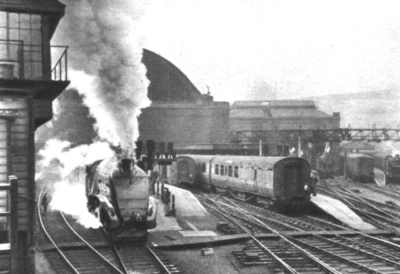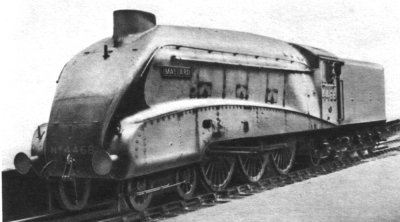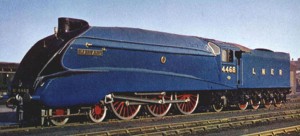A Record to Remember
I’ve never been on a fast train. Despite being interested in trains for longer than I’ve had any interest in cars, all my train trips have been pedestrian – at least in terms of pace.
The other day I travelled from Melbourne’s Southern Cross station to country Wangaratta, a train journey I immensely enjoyed. But – and here’s the pity of it – I actually thought it was reasonably quick, cos it was keeping up with cars doing 100 and 110 km/h.
In Europe, where my parents have extensively travelled, my father talks of cars on freeways being left behind so rapidly that they look like they’re going backwards. That happens when you’re in train that’s doing 300 km/h…
The Shanghai mag-lev can do over 430 km/h…
The reason these thoughts have intruded is that I have been reading about the fastest of all steam trains. As I have recounted previously, I recently bought a book published in 1950. Called Speed – the Book of Racing and Records, it covers fast machines on both land and water. And on rails too.
Like this:
There was no particular excitement at Doncaster locomotive shed on the morning of Sunday, July 3, 1938, as the beautiful blue stream-lined “Pacific” No. 4468 Mallard was being prepared for the road.
True, everyone knew she would reach 100 m.p.h. that day; but with the day-by-day 90, 95 and 100 m.p.h. attained by the Kings Cross-Newcastle-Edinburgh streamliners, the Silver Jubilee and the Coronation, the three-figure mark had lost much of its magic, even though it meant covering 146 feet every second with a heavy train.
Braking trials were the idea of the runs for that Sunday, as part of studies being made to give the celebrated streamline trains a shorter stopping distance from their “ceiling” speeds, for they needed 5,000 feet or more to come to rest from 95 or 100 m.p.h., and even then the brake blocks were known to have become red-hot.
 The train was specially selected for the day, and consisted of the London and North Eastern Railway’s dynamometer – or measuring – car and three twin-coaches from the spare train held for the London-Edinburgh “Coronation” service. Several of the railway’s technical assistants and Westinghouse Brake Company’s officials were the only passengers in the train, and Locomotive Inspector Jenkins was on the footplate along with the driver and fireman.
The train was specially selected for the day, and consisted of the London and North Eastern Railway’s dynamometer – or measuring – car and three twin-coaches from the spare train held for the London-Edinburgh “Coronation” service. Several of the railway’s technical assistants and Westinghouse Brake Company’s officials were the only passengers in the train, and Locomotive Inspector Jenkins was on the footplate along with the driver and fireman.
Approximately 100 m.p.h. was needed for the brake tests; that is, a full 13 m.p.h. below the L.N.E.R. top speed put up nearly three years before by Mallard’s sister engine Silver Fox, so no records were likely. But a day or two before, when discussing the coming brake tests, Sir Nigel Gresley, the Chief Mechanical Engineer, had been heard to “wonder whether the 113 m.p.h. could not be topped.”
That was enough, in Gresley’s day, for everyone concerned to have a go at it.
So Driver Duddington of Doncaster shed was inspanned; and Mallard, an exceptionally fast-running engine because of its double exhaust, was chosen from the list of 35 streamlined Pacifics. Duddington was known as a “speed merchant”, ever ready to make up lost time by hard running over long distances, and well backed-up by Fireman Bray.
All L.N.E.R. top speeds in those golden years, when 90’s were as common as blackberries, were attained on the gently-downhill stretch for 24 miles southwards to Peterborough. This was the best-known galloping ground on the whole of the East Coast route, and had been since the Flying Scotsman first started running in June 1862. Coming down from the north, there is a five-mile rise from Grantham to Stoke tunnel; then it is downhill through Essendine for 20 miles, and level for the last seven into Peterborough.
Speed and brake observations were made all the way south from Doncaster to Grantham; but any hidden ideas Duddington and his chiefs on the train might have had about records round Essendine way must have had a set-back here, for there was some of the usual Sunday track relaying in progress, and at half-past four in the afternoon speed through Grantham station could be no higher than 24 m.p.h.
All drivers out for lost-time recovery or high speed down the bank to Peterborough like to pass Grantham as fast as they can, unless, indeed, their train is booked to stop there, so that they can rush the five-mile bank and pass over the top at something like the mile-a-minute rate, and have a chance of getting well up into the “eighties” before they slack off a bit for the Werrington water-troughs and the 25 m.p.h. speed limit through Peterborough station.
But this hindrance was just the thing to put Duddington on his mettle. Now 1 in 200 may not seem much of a hill – you’d scarcely notice it on the road; but it’s a different matter when there is 240 tons behind the tender to be hauled to the top as quickly as possible.
 So Duddington put his regulator full open, set the valve gear at 40 per cent. cut-off, and Mallard fairly barked her way up through Great Ponton, and five miles on dived into Stoke tunnel at 69 m.p.h.; Bray, meanwhile, having been piling seven or eight big shovelfuls of coal a minute on to the roaring fire.
So Duddington put his regulator full open, set the valve gear at 40 per cent. cut-off, and Mallard fairly barked her way up through Great Ponton, and five miles on dived into Stoke tunnel at 69 m.p.h.; Bray, meanwhile, having been piling seven or eight big shovelfuls of coal a minute on to the roaring fire.
One mile further on, just past the end of the tunnel and exactly 100 miles from London, is the little Stoke signal box, right at the top of the bank, and here the train was doing 75 m.p.h. Still Duddington kept his regulator wide open and his cut-off at 40 per cent.; and the acceleration, which uphill from Grantham had been enough to raise the eyebrows, now became startling as the train got on to the 1 in 178 and 1 in 200 down grades. At the 99th post from London Mallard was up to 88 m.p.h., at the 98th post 97 m.p.h., and the train swept through Corby station, just by the 97th post, at 104 m.p.h.
This was enough for brake trials. But Duddington had heard of Sir Nigel’s “wonder,” Bray was at the top of his firing form, and Jenkins was not the man to call “halt”; so on they went, the streamliner now riding with that easy roll and gentle airy feeling of a slight lift which all these wonderful A4-class “Pacific” engines take on at 100 to 105 m.p.h.
By the time the 96th milepost was passed the train was up to 108 m.p.h., at the 95th post it was 111 m.p.h., and at the 94th had exceeded the British speed record of 114 m.p.h. held since June 29, 1937, by the London Midland & Scottish Railway “Pacific” locomotive Coronation.
Here Duddington was experimenting with an even higher cut-off in Mallard’s cylinders ; but within a mile – that is, within 32 seconds – he was back again to 40 per cent. because the extra steam couldn’t get out of the cylinders quickly enough after it had done its work, and was scarcely increasing the speed.
Back to 40 per cent., up went the speed again. At the 93½ post it topped the two miles a minute mark; at the 92nd mile-post it was 122 m.p.h., and if Duddington didn’t know the steam locomotive record speed of 124 m.p.h. put up by a huge German streamlined 4-6-4 locomotive between Hamburg and Berlin, the men in the train did, and in the dynamometer car the excitement at having well and truly broken the British railway speed record was now being capped by “Will he break the world record?”
He did. Just before the 91st milepost speed reached 125 m.p.h.; indeed, the rolling paper chart in the dynamometer car showed a tiny peak of 126 m.p.h., but not of long enough duration to be counted in a railway record, for if you are only one-fifth of a second out of dead accuracy over a distance of quarter of a mile at 120 m.p.h. your speed reading is 3 m.p.h. wrong.
Over the next mile, speed ranged at 124-125 m.p.h., the 6 feet 8 inch driving wheels making 81 revolutions every second, and each of the three pistons travelling 38 feet and stopping and starting 171 times each second.
 That was the end, for steam was shut off and the brakes applied because of the approach to Essendine station with its slight curve and several sets of points and crossings, where something a bit under two miles a minute was needed for safety. So Essendine was passed at a mere 110, and then one of the brake tests was made, and in a mile the speed of Mallard and the seven coaches – weighing 400 tons in all – was brought down from 110 to 81 m.p.h.; and at round about the 70 mark Mallard continued all the way until braking for the Peterborough stop.
That was the end, for steam was shut off and the brakes applied because of the approach to Essendine station with its slight curve and several sets of points and crossings, where something a bit under two miles a minute was needed for safety. So Essendine was passed at a mere 110, and then one of the brake tests was made, and in a mile the speed of Mallard and the seven coaches – weighing 400 tons in all – was brought down from 110 to 81 m.p.h.; and at round about the 70 mark Mallard continued all the way until braking for the Peterborough stop.
Today her world record for a steam locomotive of 125 m.p.h., and of more than 120 m.p.h. for three miles on end, still stands, and a long time is likely to pass before it is broken.
Simply fantastic stuff – and as far as I know, the record is current…

 Julian Edgar, 50, has been writing about car modification and automotive technology for nearly 25 years. He has owned cars with two, three, four, five, six and eight cylinders; single turbo, twin turbo, supercharged, diesel and hybrid electric drivelines. He lists his transport interests as turbocharging, aerodynamics, suspension design and human-powered vehicles.
Julian Edgar, 50, has been writing about car modification and automotive technology for nearly 25 years. He has owned cars with two, three, four, five, six and eight cylinders; single turbo, twin turbo, supercharged, diesel and hybrid electric drivelines. He lists his transport interests as turbocharging, aerodynamics, suspension design and human-powered vehicles.

on August 14th, 2008 at 6:36 pm
I have a photograph of the speedo in the Shanghai maglev showing 431 km/h (there is a speedo in each carriage).
The highlight of a trip to Shanghai, and it isn’t as though the rest of the city is boring.
I definitely recommend the train as the way to get between the city and the airport.
on August 14th, 2008 at 8:32 pm
I am amazed that a German train in 1938 could do 1241 mph.. that is like mach 1.6! Perhaps a typo 🙂
Cool article though. I do love trains, particularly electric trains since they are, like electric cars, the ultimate in flex-fuel vehicles. With the continued increase in fuel prices, I wonder how long it will be before a high speed train between Sydney and Melbourne via Canberra will finally become cost effective? Let’s use the French TGV as a baseline, average speed 300km/h (and maximum speed of over 570km/h). Total distance (by road) for the trip is 950km so the entire journey would take only 3 hours and 10 minutes. Considering all the mucking about one has to do in Airport lounges these days, I would be very surprised if that is not quicker than an aeroplane. Considering that the train would be city centre to city centre the train would definitely be faster! There are millions of business passengers flying between Sydney and Melbourne every year who would almost certainly jump at the chance to travel faster and safer.
on August 14th, 2008 at 10:56 pm
The Mallard is still the fastest steam train, though these days it’s an exhibit at the National Railway Museum in York. Recently the first new steam loco since the ’50s has been built from scratch at a cost of £3m – Google ‘Tornado 60163’ for more details.
on August 15th, 2008 at 4:55 am
Julian, Tremendously interesting article. Must have taken some courage to hold on to this one. Highly recommend Railway Museum in York to any & all who can make it. Some very nice looking Gold Platers in there from days of yor. As hot as this must have been, there is one as diametrically cold as could have been, from about year 1042 on woodenboat.com; click into the “editor on assignment” over the Viking Ship pic. The Viking dig museum in York is but a short lift from the Railway Museum and also worth one’s time.
on August 15th, 2008 at 9:14 pm
Australia needs a high speed train, and the Melbourne>Canberra>Sydney>Brisbane route would be brill – but it will never happen because all the do-gooders would object to the loss of the habitat of the rare one-winged butterfly or some other such creature.
It happened in China because the government said it would, and while I am not advocating that we should have a Chinese style government here, would it not be good if all our pollies were forward-looking enough to want to make it happen?
BdH
Canberra